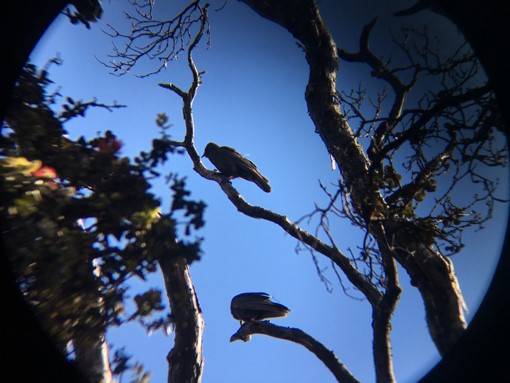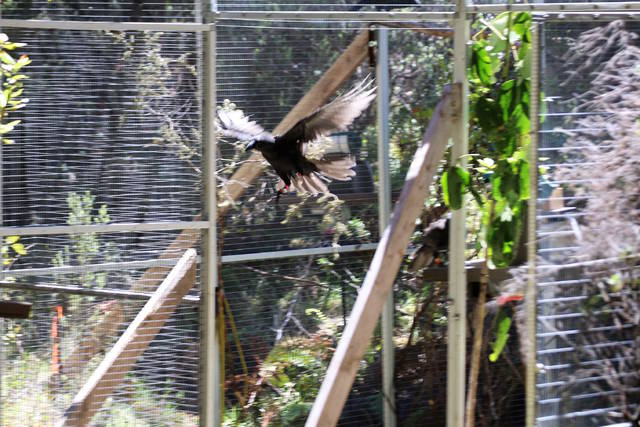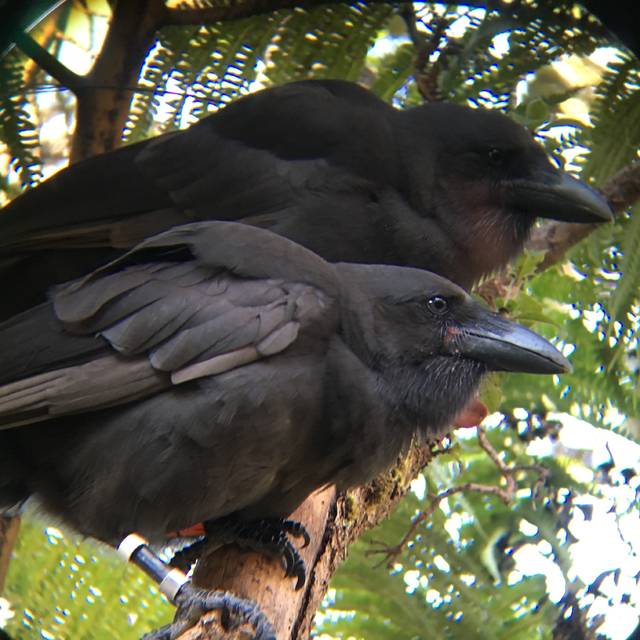HILO — One year after the successful release of 11 alala into the wild, conservationists released five more of the Hawaiian crows last week.
Five captive-reared alala, two females and three males, were released into the Pu‘u Makaala Forest Reserve on Sept. 24, bringing the number of known ‘alala outside of captivity up to 16.
The release of the five birds, as well as the continued survival of the 11 birds released in 2017, marks another milestone for the ‘Alala Project, a collaboration between the U.S. Fish and Wildlife Service, the state Department of Land and Natural Resources and San Diego Zoo Global that works to restore Hawaii’s only native crow species to the wild.
Jackie Gaudioso-Levita, ‘Alala Project coordinator, said the five birds released Monday were observed foraging for native plants within an hour of leaving their aviary. The crows have undergone wild food training to help them survive, as well as anti-predator training to identify the sights and sounds of dangerous predators.
Such anti-predator training was found to be vital in 2016, when two alala in a group of five were killed by an io, or Hawaiian hawk, shortly after release. The surviving two ‘alala from that group — a third had died from “natural circumstances” — were taken back into captivity and were released again in 2017 as part of a cohort of 11, the first of which was released Sept. 26 of that year.
So far, the 2017 cohort is adapting well to the wild, Gaudioso-Levita said. While the group regularly forages for food, they also avail themselves of food offered by the Project, Gaudioso-Levita said.
For the most part, the group stays near the area in which it was released, but the birds occasionally make exploratory flights of a mile or more away.
“We try to anchor the groups to specific sites,” Gaudioso-Levita said, adding that San Diego Zoo Global’s monitoring team tracks each of the crows through wireless transmitters so the Alala Project can observe their movements.
So far, the 2017 crows have not started nesting, but they have formed potential breeding pairs and have begun courtship rituals such as grooming each other. Gaudioso-Levita said she hopes the 2017 group will begin breeding next spring, the typical nesting season for ‘alala.
Although the five crows released Monday received the same training as the 2017 group, Gaudioso-Levita said they displayed slightly different behavior upon release. For instance, while the first crow to leave the aviary in 2017 did so within 20 minutes of the aviary’s opening, it took 53 minutes for one of the 2018 group to venture into the wild.
“I think it’s indicative that these are highly intelligent, highly social birds with their own personalities and ideosyncracies,” Gaudioso-Levita said.
To express that individuality, each of the 2018 cohort was given a name selected by local students in an online poll. Their names — Ulu (to grow or inspire), Ku‘oko‘a (freedom), Maika‘iloa (good fortune), Aumoamoa (to care for) and Kaleo (the voice) — serve as a way to connect the native birds to the island community, said Rachel Kingsley, education and outreach associate with the ‘Alala Project.
The project intends to release another group of five ‘alala in October, bringing the number of the birds in the wild up to 21.
Email Michael Brestovansky at mbrestovansky@hawaiitribune-herald.com











